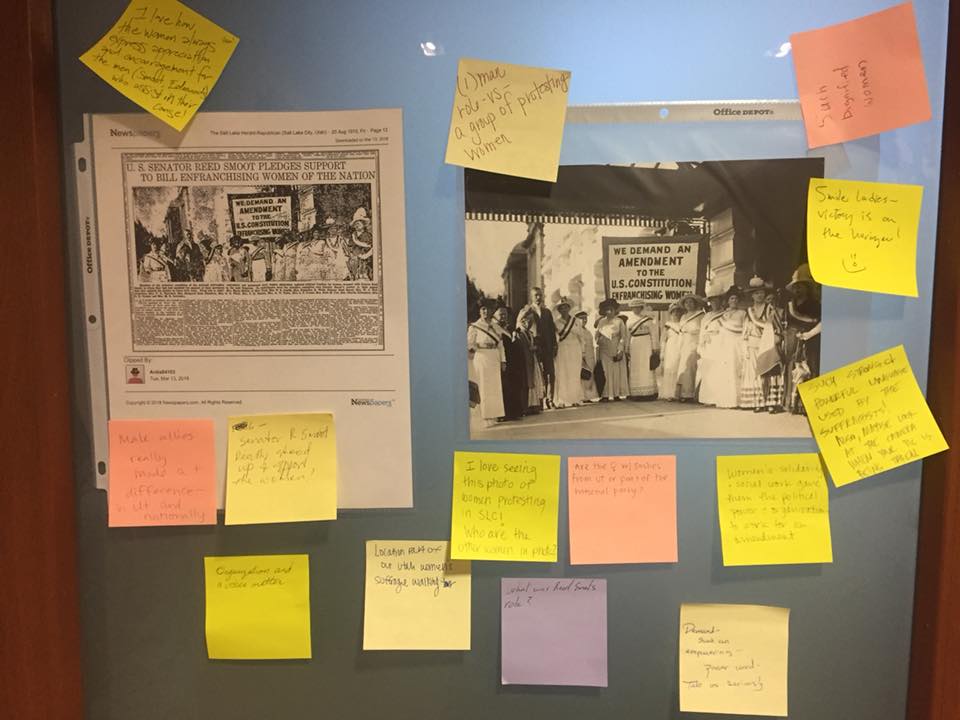UTAH WOMEN’S HISTORY / Activities and Tools
Activities and Tools
Primary sources expose students to multiple perspectives on events and issues, develop their critical thinking and literacy skills, involve them in the interpretation of history, and help with acquiring empathy. They also show students that they can be involved in history making today.
Find here tools and resources for using primary sources with students.

What are primary sources?
Primary sources are “original documents and objects which were created at the time under study. They are different from secondary sources, accounts, or interpretations of events created by someone without firsthand experience” (Library of Congress).
Examples:
- Autobiographies and memoirs
- Diaries, personal letters, and correspondence
- Interviews, surveys, and fieldwork
- Internet communications on email, blogs, listservs, and newsgroups
- Photographs, drawings, and posters
- Works of art and literature
- Books, magazine and newspaper articles and ads published at the time
- Public opinion polls
- Speeches and oral histories
- Original documents (birth certificates, property deeds, trial transcripts)
- Research data, such as census statistics
- Official and unofficial records of organizations and government agencies
- Artifacts of all kinds, such as tools, coins, clothing, furniture, etc.
- Audio recordings, DVDs, and video recordings
- Government documents (reports, bills, proclamations, hearings, etc.)
- Patents
- Technical reports
- Scientific journal articles reporting experimental research results
How do I select the best primary sources to use with my students?
Analyzing Single and Multiple Documents
Many excellent resources and graphic organizers can be used to assist students in analyzing single and multiple primary-source documents.
Select from these resources below:
Engaging Students with Primary Sources from the Smithsonian Institution — includes overviews of the different types of primary sources, their strengths and limitations, tips for reading them, and student worksheets.
Gallery Walk from Facing History and Ourselves — an activity to assist students in exploring multiple primary-source documents.
Library of Congress’s Primary Source Analysis Tool — works for photographs and prints, books, manuscripts, maps, motion pictures, sound recordings, oral histories, political cartoons, sheet music, and newspapers.
National Archives’ Document Analysis Worksheets — includes worksheets for all documents types for novice/younger students, students learning English, and intermediate/secondary students.
National Archives’ DocsTeach — an online tool for finding documents at the National Archive, but it also allows you to create your own interactive learning activities.
Identifying Bias
- Have students highlight or circle emotionally-charged language and/or words or phrases in the primary-source document that display bias.
- Ask students to explain why they highlighted/circled what they did.
- Then, require students to re-write the biased language to be less biased.
- Discuss why the source’s creator would have chosen the words that they chose. How does their word choice reflect their purpose in creating the document?
Identifying Symbolism in the Utah Woman Suffrage Songbook
- Suffragists used many symbols in order to further their cause and often used music or poetry to share their message.
- Have students read (or sing) a song from the Utah Woman Suffrage Songbook and use the worksheet below to help them engage with the symbolism of the lyrics.
- Students will depict the message of the song through drawing.
*Activity developed by Quinn Rollins
Analyzing Biographies (secondary sources)
Biographies provide a launch point to gaining an overview of an individual’s live. They can also provide access to primary sources through sources and footnotes.
Tell us your experience
We’d love to hear about your experience in using this lesson to engage with your students so that we can better serve those who choose to use this lesson in the future.
Share Your Experience
